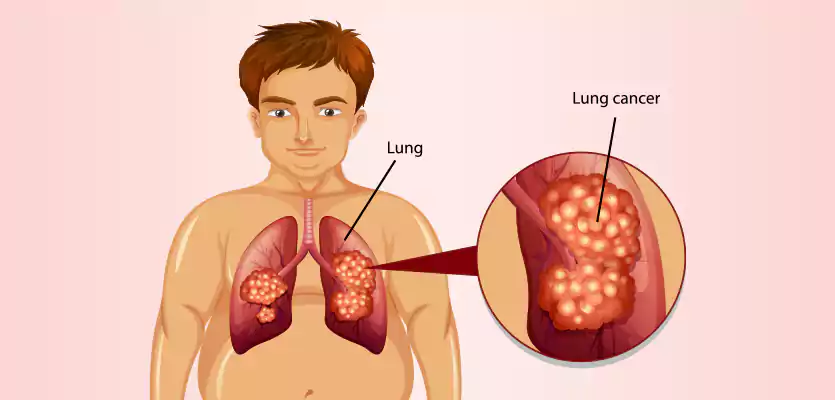Lung cancer accounts for 25% of total cancer deaths annually. This data shows that not only is it the most aggressive type of cancer but it is also the one that spreads the quickest leading to death. The metastasis or spread of lung cancer happens rapidly, affecting the internal organs and deteriorating the patient’s quality of life.
But, the most common question regarding lung cancer is identifying where does lung cancer usually spread first? And you’d be surprised to know that the spread doesn’t often come with any drastic symptoms until things are too late beyond control.
Read More in Hindi:- फेफड़े का कैंसर आमतौर पर सबसे पहले कहां फैलता है?
This article will explore more about the spread or metastasis of lung cancer and which organs and parts of the body it attacks first.
How does Lung Cancer Spread?
The metastasis or spread of lung cancer is similar to any other cancer known to man. It initiates when the cancer cells dislodge themselves from the site of the original tumor and travel down to other body parts via blood circulation or the lymphatic system.
The top five spots where lung cancer typically spreads first are:
- Liver
- Brain
- Adrenal glands
- Bones
- Lymph nodes
The five less common spots where lung cancer spreads are:
- Intestines
- Stomach
- Pancreas
- Eyes
- Skin
The degree of spread of lung cancer is also marked by the lung cancer staging concept. There are four stages. Out of the four stages, Stage IV is marked as metastatic or the more aggressive lung cancer.
Another thing that affects the degree of spread of lung cancer is the type the patient is diagnosed with. For example, small cell lung cancer spreads faster than non- small cell lung cancer.
Why does Lung Cancer Metastasize So Quickly?
Lung cancer is one of the fastest progressing cancers, leading to the highest death toll.
But why does lung cancer spread so quickly?
Since the lungs are the cellular traffic hub in the body, they are responsible for transferring oxygen to every organ and every inch of the body. This functionality of the lung makes it easier for the cancer cells to break off from the lungs and then spread to other parts, including some of the vital internal organs.
If you are confused as to why a type of cancer spreads to other organs, it is due to the cellular signals in the body.
What are the Most Common Spots the Lung Cancer Spreads?
Now that you have a basic understanding of how fast does lung cancer spreads let us walk you through the different spots it spreads to.
We briefly highlighted the top five spots in a previous section of the article. So, let’s elaborate on that.
1. Liver
Metastatic lung cancer affecting the liver accounts for30-50% of the cases. It is mostly witnessed in an advanced stage of lung cancer and demands immediate and aggressive forms of treatment to:
Either prevent the further spread of the cancer
Localize the degree of cancer that’s already spread
Most patients whose lung cancer has spread to their liver don’t experience symptoms. However, some of the ones that do report feeling signs of:
- Absence or loss of appetite
- Swelling in the leg
- Fatigue
- Jaundice (in extreme cases of liver damage)
- Weight loss
- Itching all over the body
Treatment of metastatic lung cancer in the lungs can involve two routes:
- Chemotherapy if the spread is drastic and isn’t isolated in the liver
- Surgical interventions if there is isolated tumors that can be excised and removed
2. Brain
A metastatic lesion from the lung to brain accounts for 40% of cases. It is a very common consequence insmall-cell lung cancer patients but can also happen in non-small-cell lung cancer patients.
Although 44% of patients don’t report any stark symptoms, the remaining 56% report feeling signs of:
- Headache
- Vision loss
- Seizures
- Memory loss
- Numbness
- Fatigue and weakness
The condition is considered terminal in most cases where lung cancer has spread to the brain. Instead of putting the patient through even worse and more painful treatment, the doctors emphasize palliative care to support the patient’s quality of life.
Depending on theaggressiveness of the metastasis, the other treatment options include medications to stop seizures, radiation therapy to shrink the size of the tumors, steroids, etc.
3. Bones
Like the liver, around 30-40% of lung cancer patients experience cancer spreading to the bones.
If you are wondering how quickly lung cancer spread, the rate is quite rapid and often uncontrollable. The lung cancer metastasizing to the bones often impacts the longer bones first. They also affect the spine, ribs, and hip bones too.
Most patients don’t experience any initial symptoms until the cancer cells have spread. Some of the common symptoms include:
- Pain in the joints
- Fatigue
- Weight loss
- Stiffness in the bones
Depending on the symptoms, your doctor will prescribe imaging tests to understand how much the cancer has spread to other body parts.
4. Adrenal Glands
Adrenal glands are a crucial part of the body’s endocrine system and are responsible for producing varying hormones that regulate the body’s metabolism, stress levels, and blood pressure.
Lung cancer metastasis also affects these small, triangular-shaped glands on top of the kidneys.
It is one of the most aggressive types as the patients don’t experience any symptoms. In the advanced stages, patients report experiencing abdominal pain.
5. Lymph Nodes
The last but possibly one of the most crucial sites of lung cancer spread are the lymph nodes. The metastasis typically happens via the major airways.
Generally, the spread starts with the nearby lymph nodes, and things gradually progress and worsen. Once cancer spreads to the distant lymph nodes, the condition is marked as advanced-stage lung cancer.
Treatment of metastatic lung cancer in the lymph nodes depends on the severity of the condition and the area it is affecting. Cancer cells can be surgically removed if they are isolated in the lymph nodes.
FAQs
1. Does Lung Cancer Spread Fast?
Lung cancer is one of the fastest spreading cancers in the world, leading to quicker metastasis and spread, affecting the internal organs. PET scans, ultrasounds, etc., can give a more accurate rundown of the timeline of cancer spread.
2. Can Lung Cancer Metastasis be detected without symptoms?
If you are already diagnosed with lung cancer, your doctor will regularly screen for staging lung cancer during the treatment. This gives an idea about the potential metastasis too.
3. How Long Does It Take for Lung Cancer to Metastasize?
The degree of spread of lung cancer is subjective. Reports suggest that it might take 229 days to 647 days for cancer to metastasize.
4. How long do People live with Metastatic Lung Cancer?
The National Cancer Institute reports that the five-year survival rate in a patient with metastatic lung cancer is 6.3%.
However, the prognosis depends on the stage of the cancer diagnosis. At Medanta, our team of leading chest surgeons, oncologists, and lung cancer specialists emphasize one thing – Prioritize Early Diagnosis.
If you are noticing uncommon yet persistent symptoms, discuss the same with a qualified and experienced doctor. An early diagnosis of lung cancer can put the patient in remission, provided that their cancer is treatable.
Medanta’s state-of-the-art equipment and infrastructure allow patients with prime care that supports their early diagnosis and provides a tailored treatment plan to fight the deadly disease.
For more details about lung cancer diagnosis and treatment options under the care of Dr. Arvind Kumar from Medanta, visit drarvindkumar.com.

.webp)



